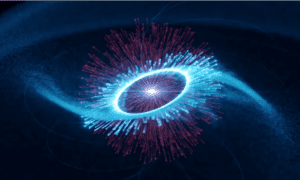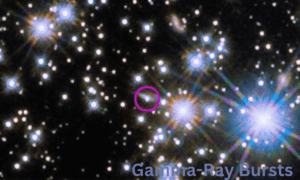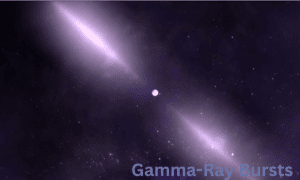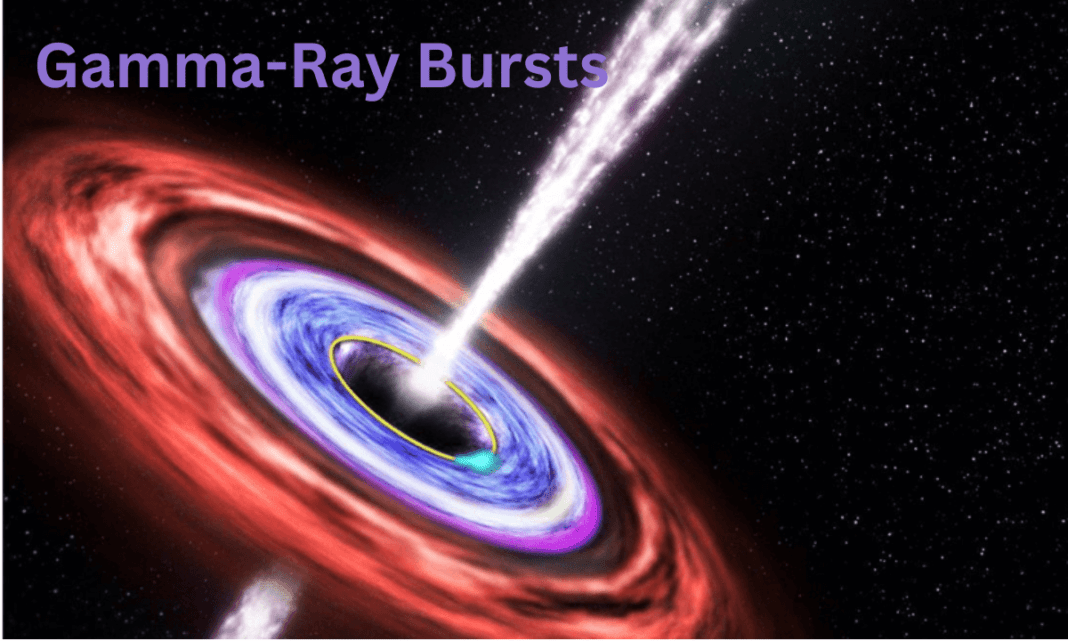Gamma-Ray Bursts Are A Mystery To Scientists.

The National Aeronautics and Space Administration has dubbed gamma-ray bursts (GRBs) “the most powerful class of explosions in the universe” due to their tremendous energy and their detection in faraway galaxies.
Since the Big Bang, these electromagnetic phenomena have been the most powerful and brightest. The third, Temporal bursts can range from a few milliseconds to hours. A more persistent “afterglow” at longer wavelengths (X-ray, UV, optical, infrared, microwave, and radio) will likely be released following a burst of gamma rays.
How Can Gamma-Ray Bursts Be Defined?
When it comes to explosions in the cosmos, gamma-ray bursts (GRBs) are on a whole other level. Some of the most explosive phenomena in the cosmos, such as neutron star mergers and the emergence of black holes, produce these short bursts of high-energy light.
According to NASA, GRBs can be as bright as a million trillion suns, lasting anywhere from a few milliseconds to several minutes. This is in comparison to the average brightness of a supernova. Therefore, for a short period after an explosion, a GRB will be the most intense source of electromagnetic radiation in the visible cosmos.
How Does a Gamma-Ray Burst Happen?
The duration of a gamma-ray burst determines its source. Short-lived GRBs (less than two seconds) are produced when neutron stars or black holes merge. A vast star’s implosion and subsequent formation of a black hole triggers longer GRBs, which can persist for hours.
Scientists believe that GRBs are caused by particle jets that are accelerated to around 99.9 times the speed of light in both instances.
What is the Magnitude of Gamma-Ray Bursts?
According to Andrew Levan, a professor at Radboud University, a gamma-ray burst can release more energy in a matter of seconds than the sun would release in its whole 9 billion-year lifetime.
Can the Milky Way Host Gamma-Ray Bursts?
Our galaxy emerged from rapid star formation around 2 to 3 billion years ago. GRBs are most commonly seen in galaxies that are currently experiencing this process. However, Supernovae remain all around the Milky Way, which shows where massive stars went out of existence. Thus, GRBs were probably here once.
Would Gamma-Ray Bursts Explode Like Bombs?
Formerly, the consensus among scientists was that any host galaxy that saw a GRB “going off” would be rendered lifeless. Most people today think this is a flawed concept because GRBs don’t explode like bombs; instead, they concentrate their power on two narrow beams, much like a lighthouse.
But it doesn’t imply they’re risk-free in every way. According to the (ESA), anything captured within 200 light-years of this beam might be annihilated without a doubt.
Gamma-Ray Bursts; Explosions In The Universe.


The origins of gamma-ray bursts, which are among the most powerful explosions in the cosmos, may finally be within the grasp of scientists.
- In perspective, the sun radiates more energy in billions of years than a single gamma-ray burst (GRB) can generate in seconds.
- Due to their strength, GRBs are thought to be produced by highly violent cosmic events, according to scientific theory.
- Examples are supernova explosions, which signal the demise of enormous stars, neutron star collisions and mergers (the densest matter known to science), and bursts from newborn black holes.
- Two characteristics of these explosions that are yet unknown are the precise process that initiates a GRB and the difference between a “long” GRB (lasting more than 2 seconds) and a “short” GRB (lasting less time).
- For example, to better simulate these eruptions and uncover their mysteries, a group of researchers from the University of Alabama in Huntsville has investigated GRBs’ light omissions and how they evolve over time.
Cigar Galaxy Illuminated by Massive Gamma-Ray Burst From’ Recently Deceased’ Magnetar.
According to team leader Jon Hakkila, a scientist from the University of Alabama in Huntsville, “the mechanisms by which GRBs produce light are still unknown, a great mystery of modern astrophysics,” even though they have been studied for over fifty years. A better grasp of GRBs sheds light on Nature’s most potent and speedy light-producing processes.
“Gamma-ray bursts (GRBs) possess such immense luminosity that they are observable throughout the entire expanse of the cosmos. Moreover, due to the limited speed at which light propagates, GRBs allow us to perceive the distant past when stars first came into being.”
Mastering Quantum Computing: The Key to the Universe’s Mysteries
Illuminating GRBs
The inability of theoretical theories to account for the behavior of GRBs’ light curves—graphs showing the evolution of an object’s light intensity over time—is a significant contributor to the phenomenon’s continued obscurity.
Burst durations can range from milliseconds to tens of minutes, and no two GRB light curves are identical, further complicating the issue.
As the fundamental building blocks of GRB emission, Hakkila and colleagues modeled GRBs as a succession of energetic pulses. When they appear, a GRB is about to brighten and disappear.


- According to Hakkila, brightness fluctuations can occur for very short periods during the emission of a GRB pulse. “The peculiar aspect of these variations is their reversibility, similar to how words like ‘rotator’ or ‘kayak’ can be reversed.”
- Scientists find it perplexing how this reversibility is feasible as time can only be comprehended in a unidirectional manner, unlike words.
- “According to him, the mechanism responsible for generating light in a GRB pulse somehow creates a pattern of brightness and then proceeds to generate this pattern in the opposite order.”
- The group zeroed in on GRB models that represent the emission of jets of particles moving near-light, or “relativistic,” speeds by newly formed black holes resulting from a massive star’s demise.
- According to Hakkila, a massive star’s core collapses, forming a black hole. The material falling into the black hole is torn apart and redirected outward along two opposing beams or jets,” according to Hakkila. We are being propelled out into space at a velocity close to that of light by the jet material.
- Everyone has always thought the jet stays pointed at us during the event because GRBs are short-lived. However, the genesis of the time-reversed pulse characteristics within a nonmoving jet has proven to be a challenging explanation.
- The team incorporated lateral motion into relativistic jets ejected from newborn black holes to account for the palindrome-like properties of GRB light curves.
- “The idea of a laterally-moving jet provides a simple solution by which time-reversed GRB pulse structure can be explained,” said Hakkila. When the jet crosses the line of sight, an observer will see the light created by the jet’s sides, the jet’s center, and the other side.
- “The jet will brighten and then get fainter as the jet center crosses the line-of-sight, and radially-symmetric structure around the jet’s core will be seen in reverse order as the jet gets fainter.”
- In this “ballistic model of GRBs,” Hakkila elaborated that relativistic black hole jets behave like a fire hose, shooting matter in an amorphous form because the jets behave more like fluids than solids, a human eye would see the whole plane as curved rather than straight.
- “The motion of the nozzle causes light from different parts of the jet to reach us at different times, and this can be used to better understand the mechanism by which the jet produces light, as well as a laboratory for studying the effects of special relativity,” said he.
The Dark Web’s Harmful Effects on Society
Find 300 Neutron Stars That Emit Gamma Rays in Massive Amounts; Some of Them are Spider Pulsars.’
Some neutron stars, known as “spider pulsars,” which eat their companion stars, hide in the massive catalog of newly discovered pulsars.
- The Fermi gamma-ray space telescope has found about 300 neutron stars that spin very fast. Like cosmic lighthouses, the newly discovered objects send two radiation beams into space.
- Millisecond pulsars are fast-spinning neutron stars..less than 10 of these objects were known to exist until the 2008 launch of Fermi. They are notable for the gamma rays, a type of highly energetic electromagnetic radiation that they emit.
- Additionally, this cluster of previously unseen neutron stars contains multiple so-called “spider pulsars,” which are thought to eat their companion stars (any stars in orbit around them) like black widow spiders eat their partners.
- Naval Research Laboratory astronomer Matthew Kerr expressed excitement about the number of millisecond pulsars detected utilizing gamma rays. Millisecond pulsars are highly accurate timekeepers.
- In his reference to millisecond pulsars as “timekeepers,” Kerr highlights their potential as mechanisms for far-space event timing due to their precise periodic rotation. With their so-called “pulsar timing arrays,” they function like cosmic clocks.
- When enormous stars exhaust their fuel for nuclear fusion, they give birth to neutron stars and fast-spinning millisecond pulsars. This prevents the release of energy from stellar cores, which have supported stars against their own gravity for eons.
- The cores of these dying stars, which have masses ranging from one to two times that of the sun, are compressed to a width of approximately 12 miles (20 kilometers) before being blown away in a tremendous supernova explosion. Neutron stars are occasionally formed after a star has collapsed.
- The extreme features observed in neutron stars are caused by the original star’s shrinkage. These features include massive magnetic fields emitting gamma-ray beams that Fermi can detect as periodic pulses and neutron-rich stuff so dense that a tablespoon would weigh one billion tons on Earth.
- As the neutron star’s diameter rapidly decreases, its spin increases, like an ice skater quickens its spin by drawing in its arms.
- Neutron stars decelerate with age. Their spin slows down, and their magnetic fields become weaker. However, unusual dead stars can gain a second wind when part of a binary system.
- “We can study these objects that began as young pulsars in a binary system,” said Kerr. They slowed down and became still, like a spinning top.
- “Recycling” these pulsars into millisecond pulsars occurred hundreds of millions of years ago when their binary counterparts dropped matter onto them, causing them to speed up again, drastically and considerably quicker than before.
Can You Explain Dark Energy and Its Impact on the Cosmos?
Trapping Intergalactic Spiders


It is interesting to note that many of these newly discovered pulsars are “spider pulsars.” Their naming stems from these neutron stars eating their binary companion stars, much like a black widow after copulation.
“Spider pulsars mimic cannibalistic arachnids. Stated Megan DeCesar, a scientist and research team member at George Mason University. The millisecond pulsar recycling process can become slightly excessive when a neutron star and its binary companion are incredibly close to one another, which can lead to a similar outcome.
Pulsar radiation erodes the surface of stars, creating puffballs. Because pulsar beams occasionally encounter the remnants of consumed stars, which block radio signals from neutron stars, Fermi is superior to other radio telescopes in detecting these spider pulsars. However, Fermi’s specialty, high-energy gamma rays, can penetrate the star debris.
“Studying spider systems will help us understand their origins and Fermi’s discoveries,” DeCesar said, adding that spider systems could be intrinsically brighter in gamma rays.
The Use of a Cosmic Clock is Explained.
One recent application of millisecond pulsars as exact cosmic clocks measured minute time variations brought about by low-frequency gravity waves—tiny rips in spacetime emitted by faraway black hole mergers and neutron star collisions.
“These are such exciting results,” stated Cromartie, a National Research Associate at the Naval Research Laboratory. “Gravitational waves reveal the centers of large galaxies.” and better understand how they were formed.”
Possible future navigational applications of pulsar timing arrays include using neutron stars, which spin at high speeds, as cosmic GPS systems to guide humans beyond Earth’s surface. Still, this finding may help limit the stability of such pulsars, which is necessary for the task at hand.
Time Travel: Can It Be Achieved?
Stunning Gamma Rays From a Pulser Shock Astronomer
Approximately 1,000 light-years away from your location is a neutron star that is both spinning and highly dense. The Vela Pulsar is a fascinating phenomenon that has caught the attention of astronomers.
It weighs the same as Mount Everest. HESS observatory in Namibia reported that it has become even more magnificent. 5). Vela appears to have released the most powerful pulsar radiation yet detected.
This object has released gamma-ray photons, which have energies of at least 20 teraelectronvolts (TeV), or twenty trillion electronvolts, and are connected with the longest wavelengths in the electromagnetic spectrum.
One electronvolt is the amount of energy that an electron gains when moved at the speed of light by an electric current of one volt.
According to Arache Djannati-Ataï, a physicist at the Astroparticle & Cosmology laboratory in France and lead of the discovery team, approximately 2,000,000 photons from a typical solar flare would be required to produce a single 20 TeV photon.
According to Djannati-Ataï, who spoke to Space.com, “one would need roughly 2×10^13 visible photons” when comparing invisible light to visible light.
Despite Vela’s rather “ordinary” 11-rotation-per-second pulsar status, the researcher argues that the object is a vital study object in astronomy due to its proximity to Earth from a cosmic perspective.
Can You Explain Dark Energy and Its Impact on the Cosmos?
“Targeting it With Our Telescopes Was Almost Mandatory!”


The usual expectation is that pulsars will not produce radiation with energies exceeding tens of gigaelectronvolts (GeV), much less the extreme range of TeVs. A gigavolt is equivalent to one billion electronvolts.
The team claims that even Vela showed a radiation emission threshold at first. In fact, people would have guessed that Vela could emit in the TeV range once they saw the enormous 20 TeV number that the researchers were able to detect.
“We searched for Vela’s pulsed emission at lower energies, but detecting 20 TeV photons was surprising,” said the researcher. Even the Crab Pulsar, over 6,000 light-years away from Earth, had emissions that did not exceed 1 TeV; no other pulsar has ever been observed with such high energy levels.
Before we delve into this high-energy observation’s ramifications, we must address another fascinating discovery about Vela.
The scientists discovered that a hitherto unidentified spectrum component of pulsars corresponds to Vela’s highly energetic photons, which runs the risk of being oversimplified.
The “spectrum” of a pulsar is a diagram showing the full range of luminous energy and intensities the item emits. (This isn’t just a pulsar phenomenon. If there is light, scientists can analyze plenty of cosmic entity spectra.
So, the researchers observed a clearly growing pattern and a distinct separation between the TeV emissions and lower-level emissions with Vela’s spectrum. Since the lower energy photons couldn’t have continued to grow until they achieved TeV status, the highly energetic photons couldn’t have continued to grow.
According to Djannati-Ataï, “This is in contrast to the Crab Pulsar,” where the energy spectrum continues its GeV emissions.
Prediction AI Is On The Way. Is Everyone Prepared (Including You)?
How Might We Use This Data?
What does this mean for the field of astronomy as a whole? First and foremost, it provides a wealth of information regarding one of the most remarkable objects in the cosmos.
Pulsars are unique, according to Djannati-Ataï, who described them as cosmic objects in a zoo. They are cosmic labs with remarkable features we cannot reach on Earth.”
The history of pulsars is remarkable in and of itself. They are composed almost entirely of neutrons and occasionally send radiation beams that traverse our solar system. They are the spinning remains of stars that have previously died in a supernova explosion.
Those sweeps, which occur at regular intervals, may really map out the spectra of these entities.
Scientists investigate the space surrounding pulsars to test critical physics theories, as Djannati-Ataů mentions when he calls them “cosmic laboratories.
” This extremeness is another reason for their study. Mainly, pulsars are among the most gravitationally dense objects in the universe. Therefore, scientists are curious whether Albert Einstein’s theory of general relativity still applies to them. That being said, to the best of our knowledge, it does.
Understanding pulsar radiation’s origins is severely limited by these discoveries, according to Djannati-Ataï. Current scientific consensus holds that the pulsar’s magnetosphere originates these fast-moving electrons, which reach the object’s outer edges.
However, additional processes are required to generate emissions with energy up to 20 TeV. Therefore, this model fails to adequately account for the team’s findings.
Researchers have some theories but plan to collect more data to fill the gaps. As it is, we can take pleasure in knowing that these findings formally pave the way for a new era in the study of space exploration.
According to Djannati-Ataï, “TeV pulsar astronomy is born!”
Thank you for taking the time to read my story. If you enjoyed it, please consider following me on Medium and LinkedIn and subscribing to my website newsletter for more stories in various categories. Have a great day!




